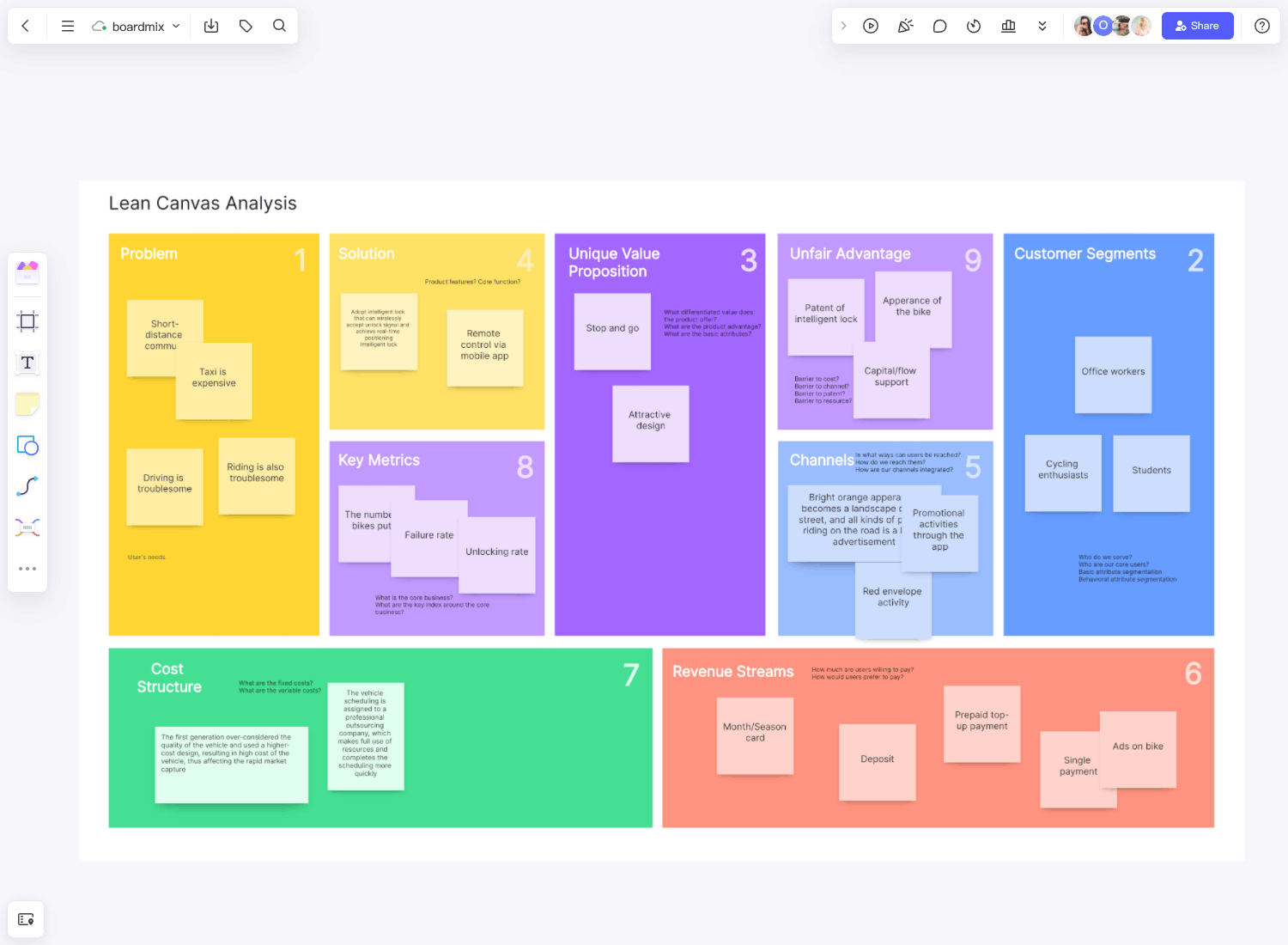Every business owner recognizes the pivotal role a comprehensive business plan plays in effective business management. Yet, circumstances occasionally call for a more streamlined approach, one that distills essential insights without the complexity of a full-fledged plan. In such instances, a Lean Canvas emerges as a valuable solution, offering a concise and readily comprehensible snapshot of your business dynamics.
For those unacquainted with this concept, this article not only underscores the advantages of embracing a Lean Canvas but also guides you through the step-by-step process of crafting one through the utilization of a purposeful template. This dynamic tool serves as a condensed yet potent framework, enabling you to highlight key aspects of your business while fostering clarity and strategic insight. Whether you're a novice or an experienced entrepreneur, the Lean Canvas is a valuable asset for a concise, focused business overview.
What Is a Lean Canvas?
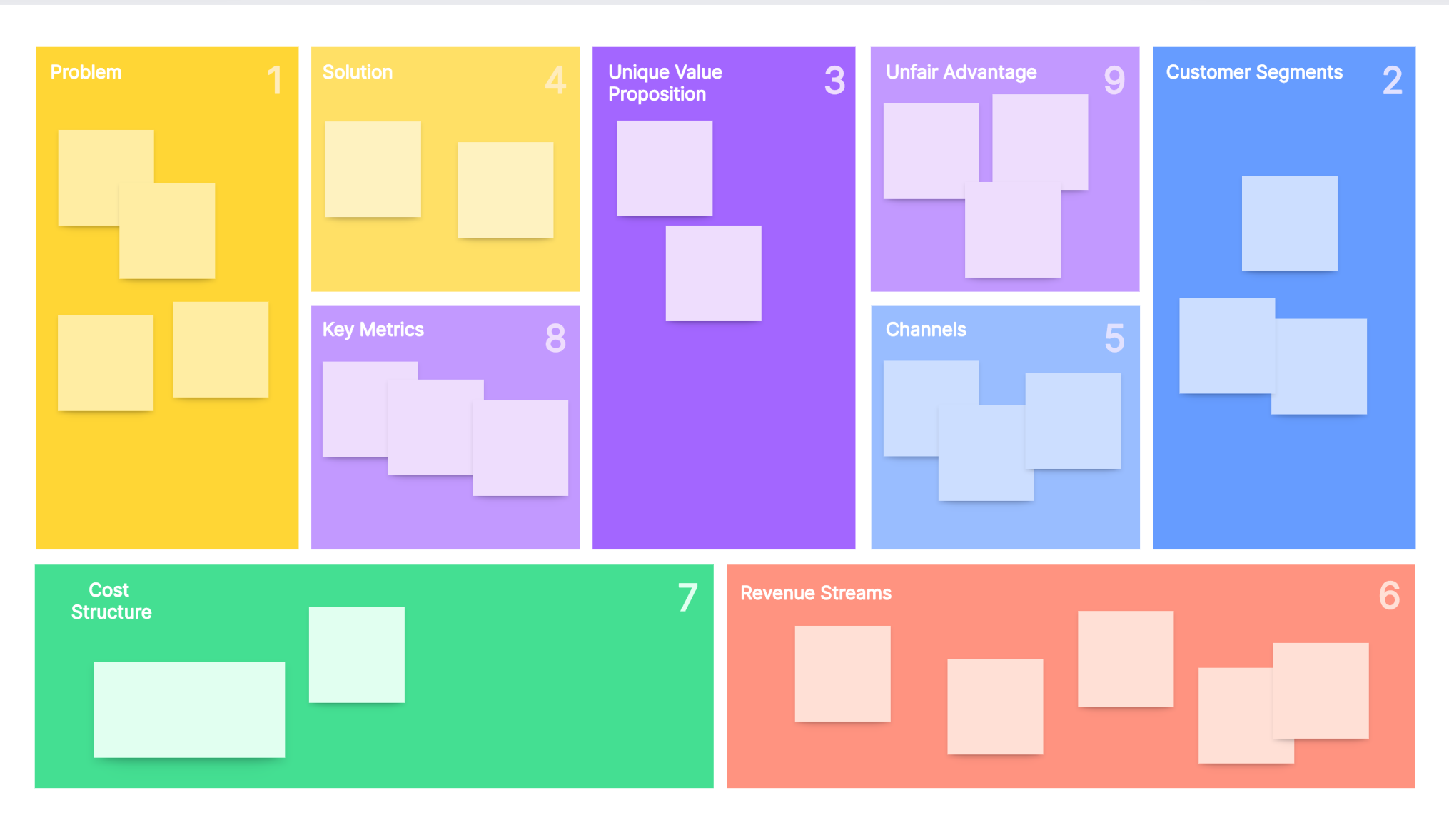
A Lean Canvas is a type of business plan that consists of only a single page. It is a very simple but highly efficient variation of the business model canvas which, while thorough, can also be very meticulous to create. The Lean Canvas compresses all the vital concepts of a business plan into a 1-page diagram that can easily be understood at a glance.
Benefits of the Lean Canvas
There are plenty of benefits that can be gained from using a Lean Canvas template for business planning and strategizing. If you are trying to determine the feasibility of a business model, for instance, a Lean Canvas would easily help you identify the different factors that have an impact on the business.
Simple and Quick
Compared to most traditional business tools, the Lean Canvas Template is remarkably simple and quick. The format is easily understandable even for regular staff members, facilitating meaningful contributions from all participants. Additionally, its straightforwardness ensures cost-effective creation.
Clear Business Overview
Operating a business is a very complex job, and it won't benefit anyone to make the business goals and overall direction complicated as well. The Lean Canvas Template consists of just one page where there is no room for minute details, which are all in the comprehensive business plan anyway. What this document does is to give everyone focused on the overall objective by providing a very easy-to-understand overview of the business.
Combines Internal and External Factors
The Lean Canvas Template presents a completely balanced picture of the business because it takes both the company’s strengths and outside threats into consideration. It is not just an idealistic view of the business that you might be aiming for, but rather a realistic picture that shows how both internal and external factors create an impact on the business. Through this picture, you will be able to make necessary improvements and upgrades to enhance operations.
6 Lean Canvas Examples
Following are 6 examples of lean canvas for your startup. To make things easier, your first step is to create an account of Boardmix. This online collaboration whiteboard tool provides you with numerous readymade templates to create any type of diagram you need. In addition to this, Boardmix has just introduced an AI assistant that can not only collect data but also analyze them.
Lean Canvas Example of Apple

In Apple’s lean canvas example, we can see that the main problem is that computers were far from user-friendly. Thus, the user segment should be everyone using a computer, such as office workers and students. So, the solution and unique value proposition of the company is a portable computer with exceptional usability and modern design.
The channels they’ve chosen are advertising, direct communication with customers, and word of mouth. The revenue stream comes from direct sales, and the cost structure contains the production and marketing costs. The key metrics for Apple are the ROI and the number of loyal customers. Finally, the brand’s unfair advantage is its clear and concise strategy for future releases.
Lean Canvas Example of SpaceX
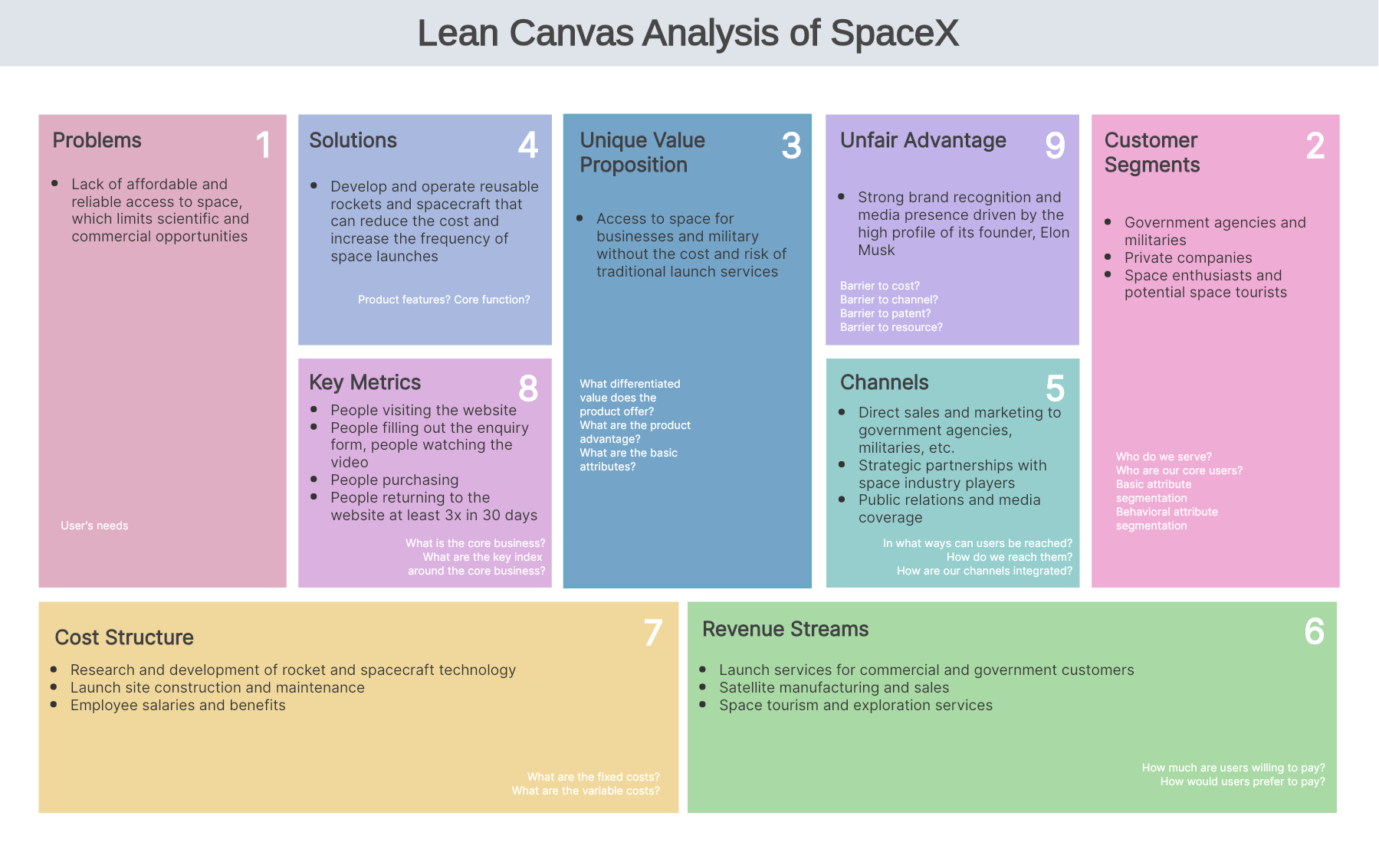
The lean model canvas of SpaceX states that the problem they are trying to solve is the lack of affordable access to space. Therefore, the customer segment consists of government organizations, the military, private companies, and space enthusiasts. The brand approaches these potential customers with the unique value proposition of getting to space without cost and risk since their solution is to develop reusable spacecraft parts.
The channels that SpaceX has selected are public relations, strategic partnerships, and direct sales. The brand’s revenue comes from the launch of services, the manufacturing of satellites, and space tourism. The cost structure includes research and development of new spacecraft technologies, manufacturing of the products, and marketing costs. The key metrics for SpaceX are their ROI and their website’s performance. Finally, the unfair advantage of this company is the strong brand recognition due to its founder, Elon Musk.
Lean Canvas Example of Tesla
Tesla’s lean canvas example shows you that the main problem is the promotion of eco-friendly cars to more people. Thus, they are targeting eco-conscious drivers and sports car lovers. The brand’s unique value proposition and solution is electric cars with efficient performance.
The channels that Tesla is using are advertising, interaction with buyers, retail stores, and word of mouth. Their revenue comes from direct sales and venture capital, and their cost structure consists of car production and advertising. Tesla’s unfair advantage is Roadster, which is the most recognizable electric car.
Lean Canvas Example of Amazon
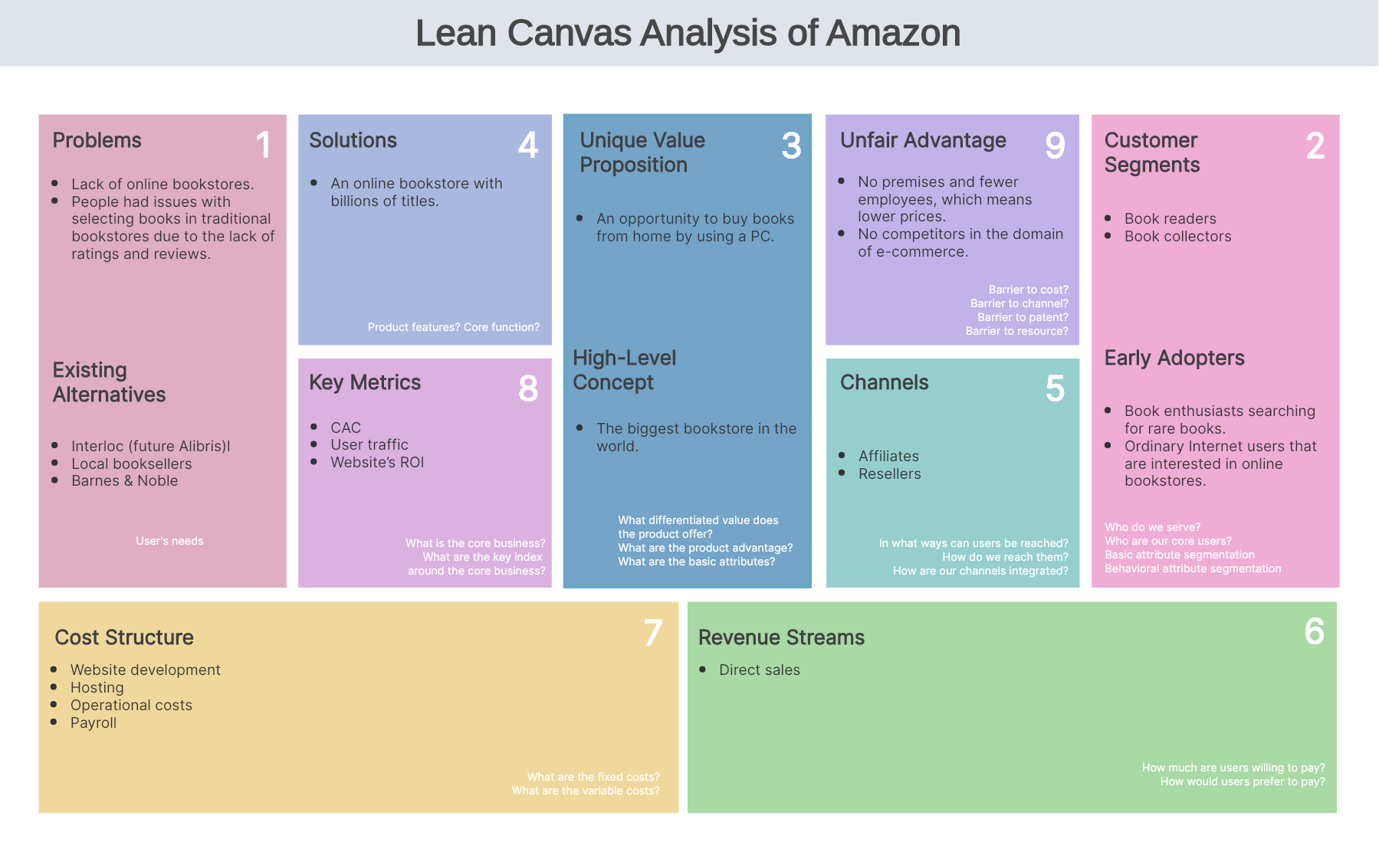
Amazon’s lean model canvas example refers to the time of its launch back in 1994. Then, the main problem was a lack of online bookstores and readily available book ratings. Therefore, the company introduced the unique value proposition of purchasing books online through an online bookshop with millions of available titles.
The channels that we see on the template are affiliates and resellers of books. Amazon’s stream comes from direct sales, while its costs contain the website’s development, hosting, and maintenance. The key metrics are the customer acquisition cost and the ROI. Finally, Amazon’s unfair advantage is that it doesn’t have any premises or employees, which lowers the products’ prices.
Lean Canvas Example of Google
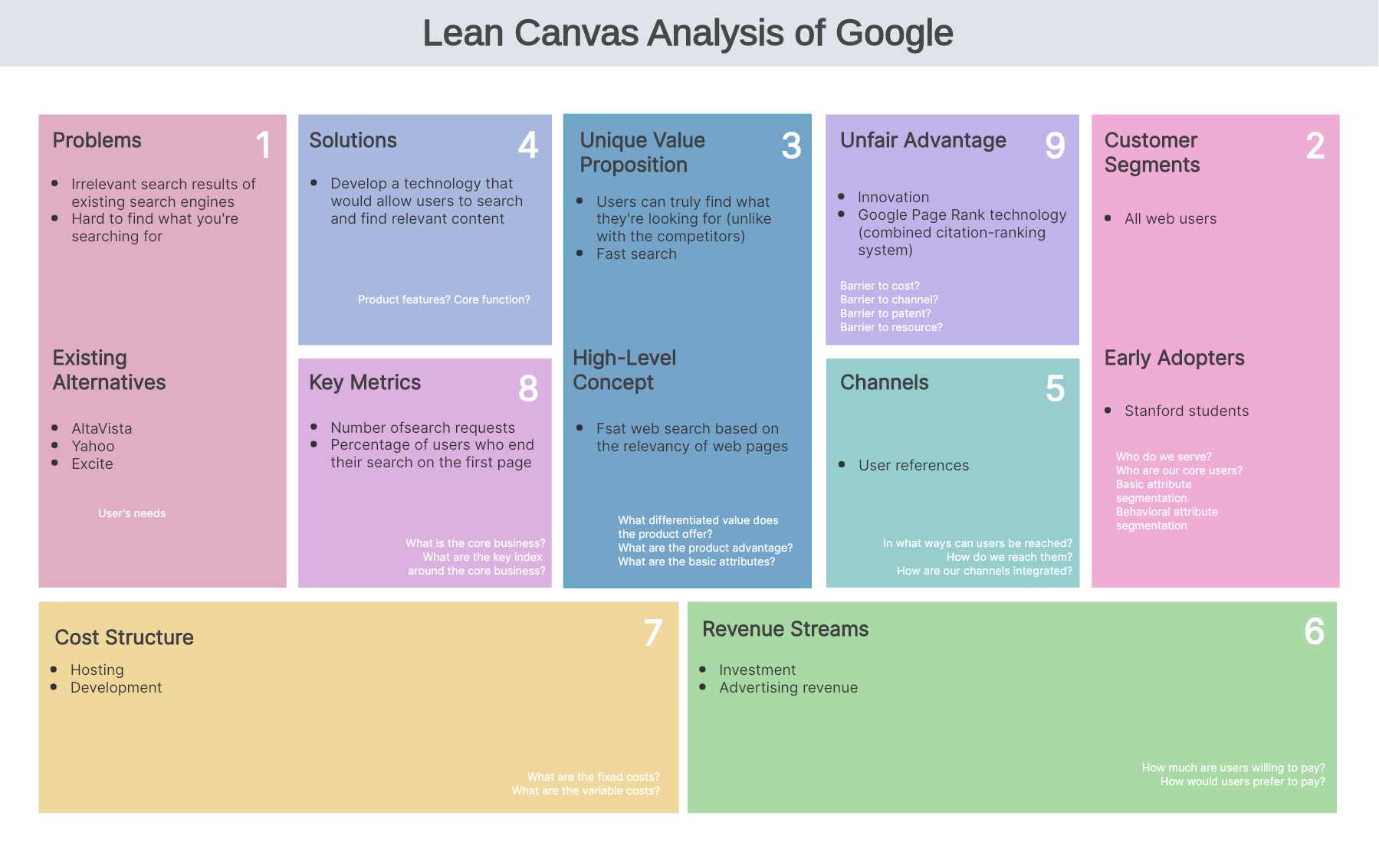
The following lean canvas example shows that Google’s main problem is the irrelevant Internet search results. Therefore, the unique value it offered to all web users was a new technology that would allow them to search quickly for whatever they needed to.
It’s interesting to see that the only channel Google is using is user references. The company’s revenue comes from investments and advertising, while its costs consist of the tool’s development and hosting. The key metrics are the number of search queries and how many results each user is browsing. The unfair advantage of Google is the innovation it brought.
Lean Canvas Example of YouTube
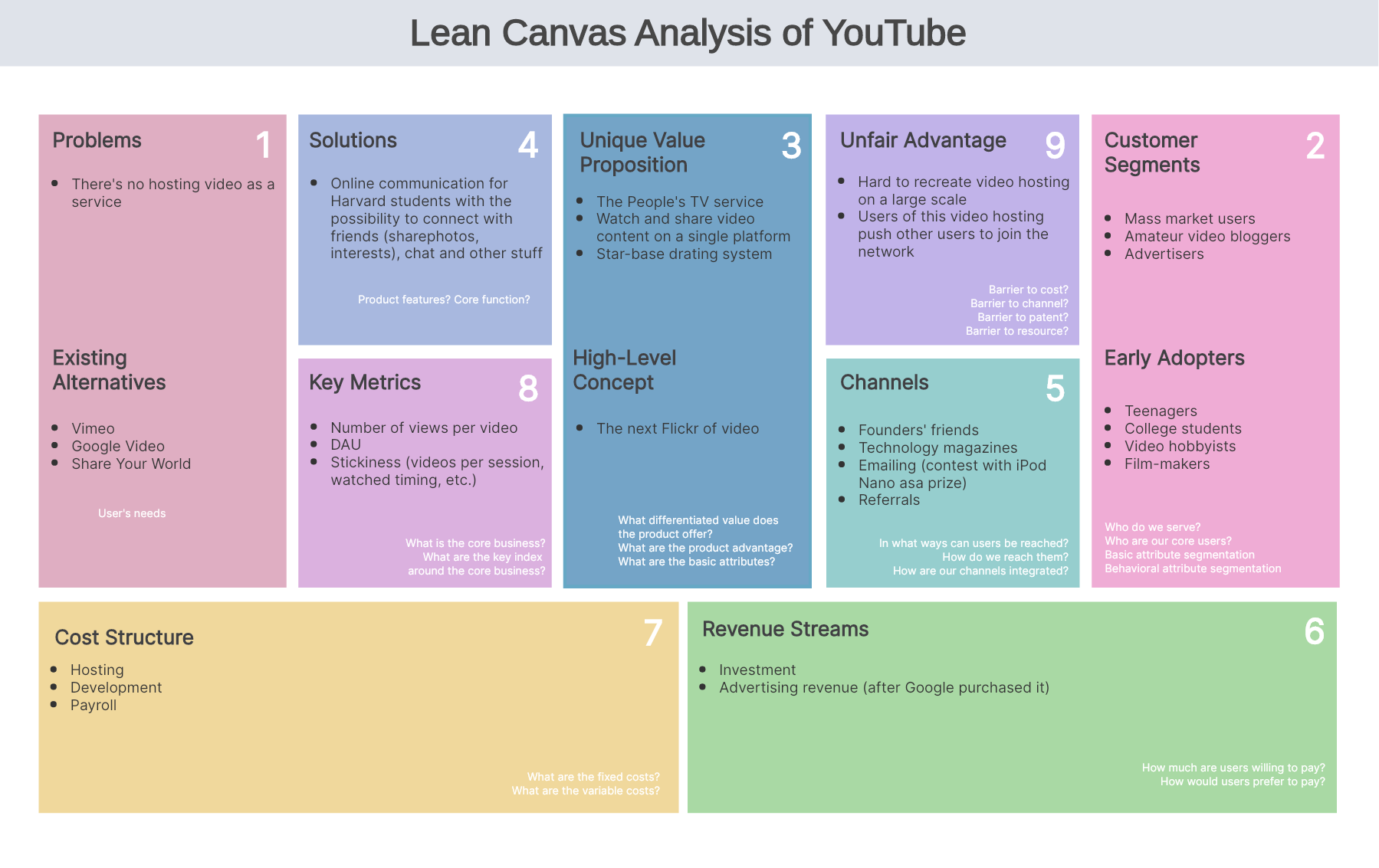
YouTube recognized that there wasn’t a hosting video service, as you can see from their lean model canvas. Therefore, its unique value proposition was that everyone could upload, find, share, and rate videos through a dedicated website.
The channels that YouTube selected for their business were referrals, email marketing, technology magazines, and personal connections. The revenue stream contains investment and advertising and the cost structure includes the platform’s development, hosting, and maintenance. YouTube’s unfair advantage was the difficulty of recreating a platform such as this one.
How to Use a Lean Canvas in Boardmix
Boardmix is a cutting-edge, user-friendly online whiteboard platform, specifically engineered to foster collaborative endeavors. It's particularly effective for tasks requiring collective input and brainstorming, such as the creation of lean canvases. Its intuitive design coupled with a suite of robust features makes Boardmix an ideal tool for facilitating teamwork, encouraging creative problem-solving, and driving strategic planning sessions.
1. Sign up or log in to Boardmix.com.

2. Go to the Templates center and choose the Lean Canvas template.

The Lean Canvas template at Boardmix has a very similar format to the Business Model Canvas Template. If you have already used the business model canvas template, it’s the same but on a broader level and with the focus directly only on the entrepreneur.
3. Click Use to apply this template.
Before commencement, it's crucial to grasp the overall concept of your business. Define your target customers, the issues you aim to address, and your proposed solutions. To ensure comprehensive coverage, engaging the entire team in canvas creation is advisable.
4. Then fill every part according to your case.

Once you have answers to these questions, you can now start building a Lean Canvas using the Boardmix Lean Canvas template. The layout is very simple, with colored boxes that you need to fill out by answering the questions in each box. Keep going until you have entered all the relevant information into the corresponding boxes.
Tips and Best Practices to Get the Most out of the Lean Canvas Template
To maximize the benefits that you can get from the Lean Canvas template, it is strongly advised that you take a proactive approach in the process, rather than just methodically filling the boxes with ideas.
Start by choosing a problem, then filling out each subsequent box with this problem in mind. This is a much better approach than trying to think of every single problem before moving on to the next box. With a sequential approach, you will have a more natural flow, and the ideas will come more freely to you and your team.
Identify means for measuring the growth and success of your business. You need to define the metrics by which you can gauge whether your business is progressing or not. The costs and revenue streams must be taken into consideration as well.
Conduct thorough customer research to discern their genuine desires and requirements, and identify the key challenges they seek solutions for. Immerse yourself in the market, enabling you to pose direct inquiries and make insightful observations. These efforts will contribute to establishing a robust and actionable foundation for your Lean Canvas.
Get feedback from others. The best way to strengthen and improve your ideas is to get input from partners, advisors, staff, and other key entities that have an impact on your business. Their criticisms, questions, suggestions, and whatnot are crucial as these will expose the weaknesses of your proposal as well as highlight its stress. Thus, you will be able to make the needed modifications to make it into an even better plan.
Throughout the process of using the Lean Canvas template, always make it a point to be brief. This canvas must be easy to comprehend at a glance. Leave details to the business plan and other documents.
Make adjustments as necessary. This is not just about addressing the feedback that you got. The Lean Canvas Template is a flexible structure that can be changed as many times as you need. If you discover new ways to satisfy the needs of your clients, you can incorporate these into the Lean Canvas. Business is always evolving and the Lean Canvas will easily evolve as your business grows.
FAQs about the Lean Canvas
How does a Lean Canvas distinguish itself from a Business Model Canvas?
At first glance, they might look the same but a Lean Canvas is meant mostly for start-ups while a business model canvas is for creating a new business or updating an existing one. Also, a business model canvas addresses all the entities involved in the business, such as the entrepreneurs, consultants, advisors, and customers, while the Lean Canvas template directs focus only on the entrepreneurs.
What are the 9 components of the Lean canvas?
The 9 components of the Lean Canvas template, which must all be included in the following sequence to maximize efficiency are: problem, solutions, key metrics, unique value proposition, unfair advantage, customers, channels, cost structure, and revenue streams.
How to review your lean canvas?
After you finish making your Lean Canvas, look back at it and see if you have covered everything. Did you write all the possible solutions to the problems? Did you mention all the types of customers you hope to serve? Make the necessary adjustments after the review. Please be aware that conducting regular reviews of the Lean Canvas is crucial, as factors continually evolve, requiring strategic alignment. Regularly revisiting your Lean Canvas is vital to ensure its alignment with evolving factors and adjust strategies accordingly.







